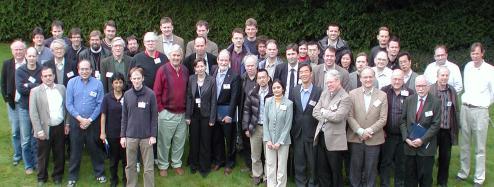
More than 50 experts from around the world gathered at TRIUMF on March 27-28, 2008, to assess current progress in--and future directions for--research in understanding halo nuclei. The Halo 08 Workshop brought together participants from Europe, Japan, and North America to discuss the review TRIUMF's impact on the field. In addition, the workshop covered future avenues of research and preparation for TRIUMF's next five-year funding proposal. The international workshop was organized by Saint Mary's University and TRIUMF.
Halo nuclei are nuclei with extra neutrons or protons which occupy classically forbidden orbits. Although nuclear halos were discovered in 1985, they are still not fully understood. Most people are used to thinking of the atom as a miniature solar system with the electrons as "planets" that go around the central nucleus. What is fascinating is that scientists have found that the nucleus itself can have "halo" neutrons (or protons) that "orbit" at relatively large distances around a central nucleus. An an example, halo nucleus Li-11 is as big as Pb-208 because two of the neutrons "orbit" the rest of the nucleus.
With its ample supply of isotope beams of these halo nuclei, TRIUMF has supported experiments covering halo propagation in beta-decay, charge radius determination, mass and binding energy determination, bi-neutron correlations, and halo-fusion.
A key finding of the workshop was that the field needs measurements at many different experiments and facilities, however the most sensitive measurements require high yield and excellent beam quality. These requirements play to TRIUMF's strengths and its ISAC facility. The group also mapped out the significant impact that an actinide-target program could have in nuclear-halo physics. The workshop found that experiments at TRIUMF dominate and drive the field. Researchers from Japan, France, Germany, Poland, Belgium, USA, and Canada come here to do experiments. The participants strongly endorse current program and prospects for future.
The international organizing committee included H. Geissel (GSI/U Giessen), I. Tanihata (RCNP/Osaka), A. Richter (TU Darmstadt), W. Mittig (NSCL/MSU), and G. Drake (Windsor). A formal written report is in preparation and will be submitted to Nuclear Physics News.
by Tim Meyer
TRIUMF's Head of Strategic Planning & Communications
